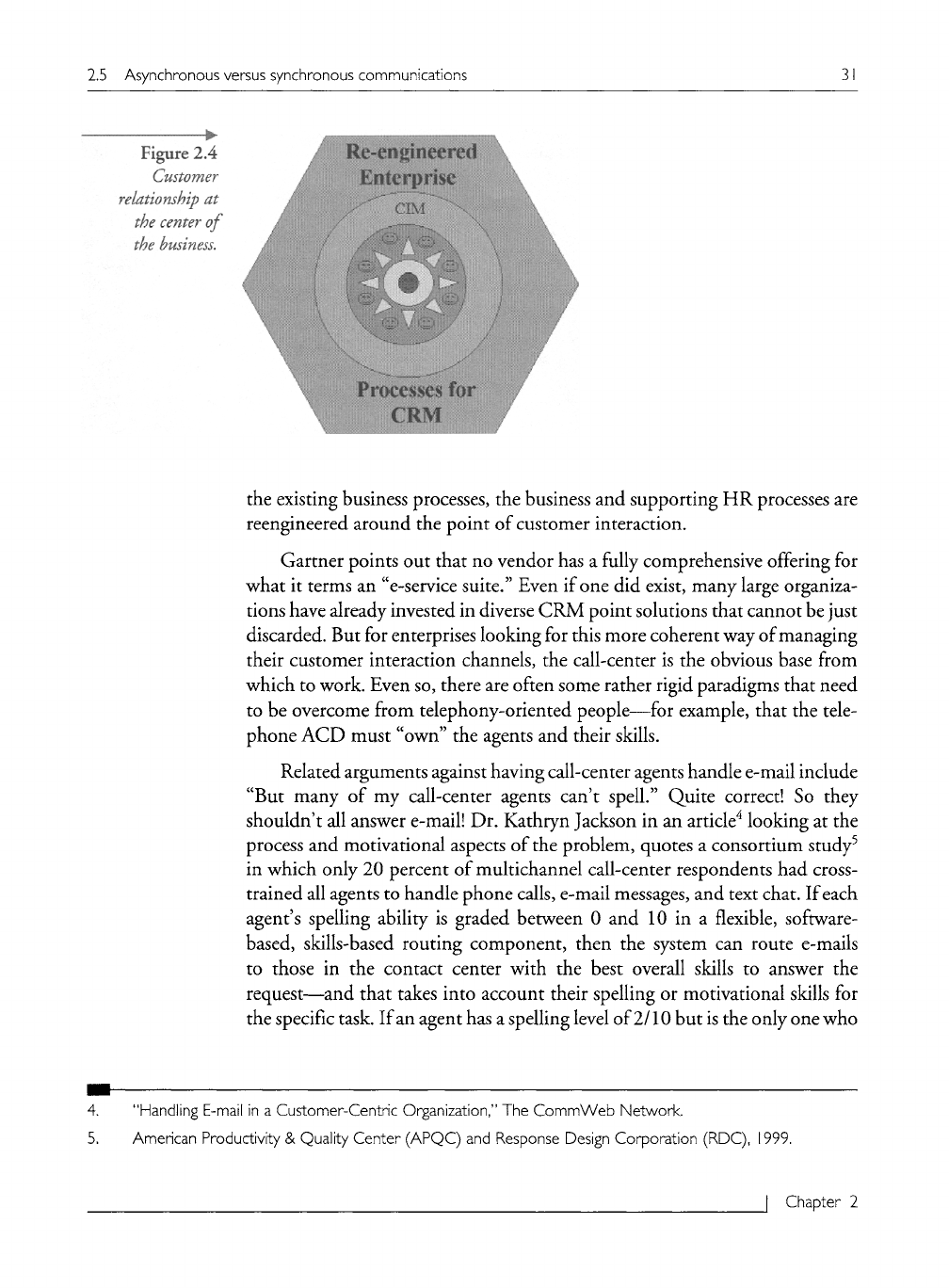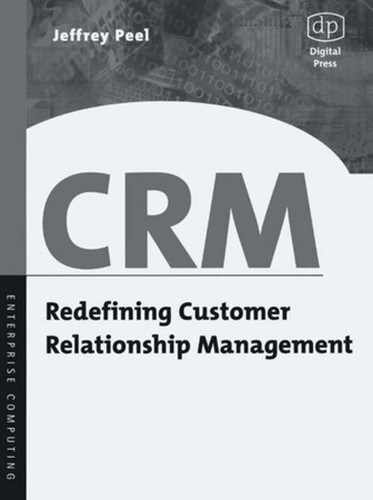
30 2.5 Asynchronous versus synchronous communications
account balances, differing pricing information, or the perceived
invisibility of recent transactions. Such experiences often lead to a
lack of confidence in the business by the consumer, and puts cus-
tomer retention at risk.
o
A noncoherent interface for the contact center with multiple sys-
tems for the agents to log on to, multiple skills tables for the
supervisors to maintain, and a lack of flexibility in agent blending
between different channels.
0
Inefficient use of the skilled personnel resources across the "islands"
of solutions created.
,
A nonholistic approach to managing the customer relationships.
Many enterprises are trying to evaluate how to progress from the situation
shown in Figure 2.2 toward the ideal of the flexible environment shown in
Figure 2.3, where a common team of agents can potentially be blended into
handling all the customer requests from whichever channel they choose to use.
This can be seen as the first step toward a full CRM management environ-
ment (Figure 2.4), where rather than having the contact center "bolted onto"

2.5 Asynchronous versus synchronous communications 31
the existing business processes, the business and supporting HR processes are
reengineered around the point of customer interaction.
Gartner points out that no vendor has a fully comprehensive offering for
what it terms an "e-service suite." Even if one did exist, many large organiza-
tions have already invested in diverse CRM point solutions that cannot be just
discarded. But for enterprises looking for this more coherent way of managing
their customer interaction channels, the call-center is the obvious base from
which to work. Even so, there are often some rather rigid paradigms that need
to be overcome from telephony-oriented people~for example, that the tele-
phone ACD must "own" the agents and their skills.
Related arguments against having call-center agents handle e-mail include
"But many of my call-center agents can't spell." Quite correct! So they
shouldn't all answer e-mail! Dr. Kathryn Jackson in an article 4 looking at the
process and motivational aspects of the problem, quotes a consortium study 5
in which only 20 percent of multichannel call-center respondents had cross-
trained all agents to handle phone calls, e-mail messages, and text chat. If each
agent's spelling ability is graded between 0 and 10 in a flexible, software-
based, skills-based routing component, then the system can route e-mails
to those in the contact center with the best overall skills to answer the
request~and that takes into account their spelling or motivational skills for
the specific task. If an agent has a spelling level of2/10 but is the only one who
m
m
"Handling E-mail in a Customer-Centric Organization" The CommWeb Network.
American Productivity & Quality Center (APQC) and Response Design Corporation (RDC), 1999.
I Chapter 2

32 2.5 Asynchronous versus synchronous communications
m
m
can speak Croatian, the supervisor might still want to route the e-mail to that
agent! 6
The type of architecture to support this capability is starting to emerge in
the marketplace, although, as Gartner pointed out, there is no clear leader as
yet. Vendors have a variety of names and definitions for the different compo-
nents, but it can be broadly described as containing a number of specific
components, as follows:
9 A universal connection management (UCM) component, which
understands the skills and resource requirements of incoming channel
requests and matches them to its knowledge of available resources
(agents, IVR ports, etc.) in the enterprise.
9 A case management component, which can intelligently collate histori-
cal information and develop cross-sell or up-sell opportunities for the
customer interaction.
9 A personalization engine, which tailors the channel experience accord-
ing to the likes and dislikes of the customer or customer set.
9 A transaction engine providing linkage to the legacy transactions and
data, often linked to a business workflow system of some kind.
9 A set of collaboration functions or processes that allows contact-center
staff to engage with external communities within the organization.
A vital element lies in the associated management capabilities~monitor-
ing, control, and statistics~to assess the ongoing state of the customer
interaction metrics and allow for service levels to be set and managed on a
per-channel, per-customer-set basis.
A key enabler in this picture is the use of multitier messaging technologies
(e.g., IBM's MQSeries or BEA's Weblogic) to provide one, and only one, cus-
tomer data model to be shared by the front-end channels. This data model
may exist within a traditional database, such as DB2 or Oracle, or it may be
constructed logically within the messaging middleware layer from a range of
customer data sources. (IBM's MQSeries Integrator is an example of this
approach.)
This chapter has discussed some of the technical and business factors
associated with integrating asynchronous messaging into a call-center envi-
ronment. While a wide range of tactical point solutions are available and no
It's also worth noting that the automatic intelligent creation of draft e-mail responses for agents by
the latest mail manager applications negates the need for agents to do much creative writing anyway.

2.5 Asynchronous versus synchronous communications 33
clear strategic leader has yet to emerge, any implementation in this area
needs to consider the wider strategic implications of convergence toward a
customer relationship management strategy (and the associated customer
interaction management architecture) for the enterprise. This chapter also
makes clear that there is a need to see beyond "big bang" CRM and to focus on
customer interaction, effective communication, and engagement.
I Chapter 2

..................Content has been hidden....................
You can't read the all page of ebook, please click here login for view all page.
